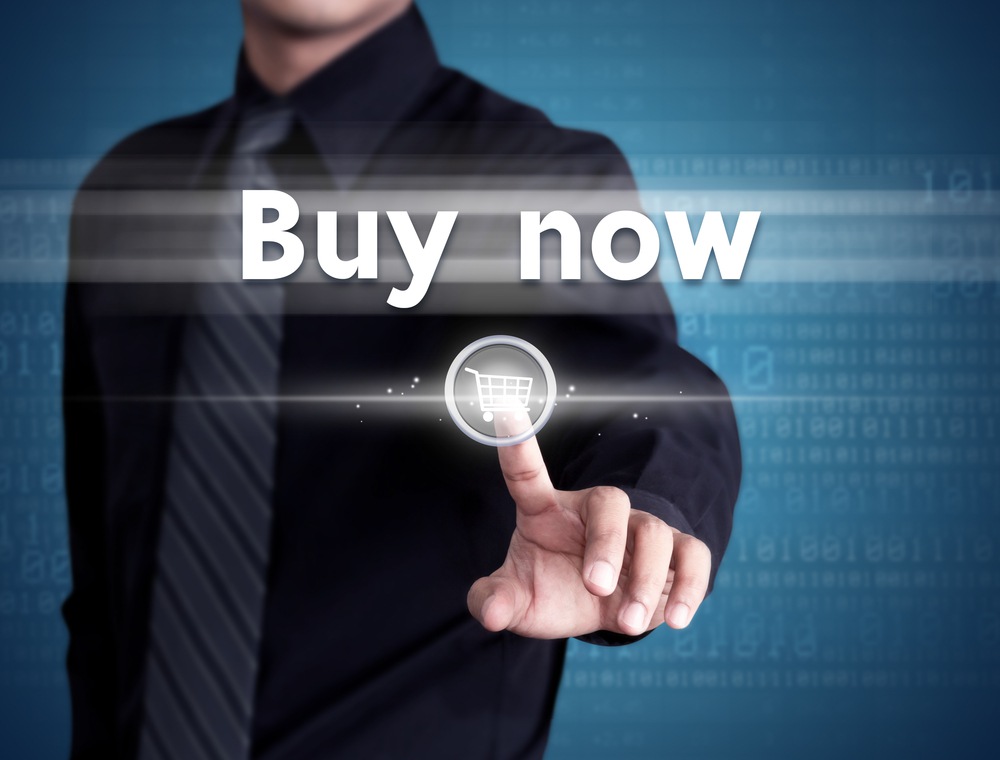It’s harder than ever to get consumers to take action, and advertising is to blame.
We all know that marketing has moved from traditional advertising to more two-way communication. The old sparkle words (CLEANER! FRESHER! FASTER!, etc.) have now been replaced by hashtags, and TV, radio, magazine and billboard ads are second to customer reviews.
But how did this happen?
The answer is that we took traditional advertising a little (or a lot) overboard. CBS reports “We’ve gone from being exposed to about 500 ads a day back in the 1970’s to as many as 5,000 a day today.”
Such advertising overload has generated clutter and skepticism. People no longer accept ads at face value. Today, they want to read customer reviews, participate in free trials, and research similar brands before they act. In response, companies have shifted their marketing emphasis from traditional advertising to word-of-mouth.
And word-of-mouth comes from people talking about their experiences. Therefore, there’s been a lot of stress on creating great ones. Food is fresh, clothes are stylish, and gadgets work the first time. People now expect great performance from products and services.
In this way, all brands seem pretty much the same.
Lovemarks
Yet, there are some brands that just AREN’T the same as all the others. There are those brands that make people act time and time again without a second thought, even though competitors might offer a similar product. We all know someone who will only buy Apple products, refuses to drink coffee if it’s not from Starbucks, or won’t drive a vehicle unless it’s a Toyota. They don’t care about customer reviews or price. There’s simply no reasoning with them. They act without logic.
Why? Because they’re in love with that brand. According to global advertising company Saatchi & Saatchi, these brands are called Lovemarks, or companies that actually transcend brands by creating an intimate, emotional relationship with their consumers. Lovemarks have loyal customer bases that really love their product and simply can’t live without it.
Lovemarks are more than products – they’re habits.
Obviously, the ultimate marketing goal is to become a Lovemark. Customers that habitually interact with your brand are a marketing dream. And don’t think only big name brands like Apple can do it – people fall in love with their favorite local restaurants, barbershop, tax service, etc. all the time. You’re a Lovemark simply if your customers say, “I won’t go anywhere else.”
But first things first: you have to get people to try out your product. After all, no one can fall in love with something they’ve never tried.
Getting People to Act
But how do you get people to try you out? You need to inspire them to take action, whether it’s buying your product, subscribing to your service, or downloading a free trial.
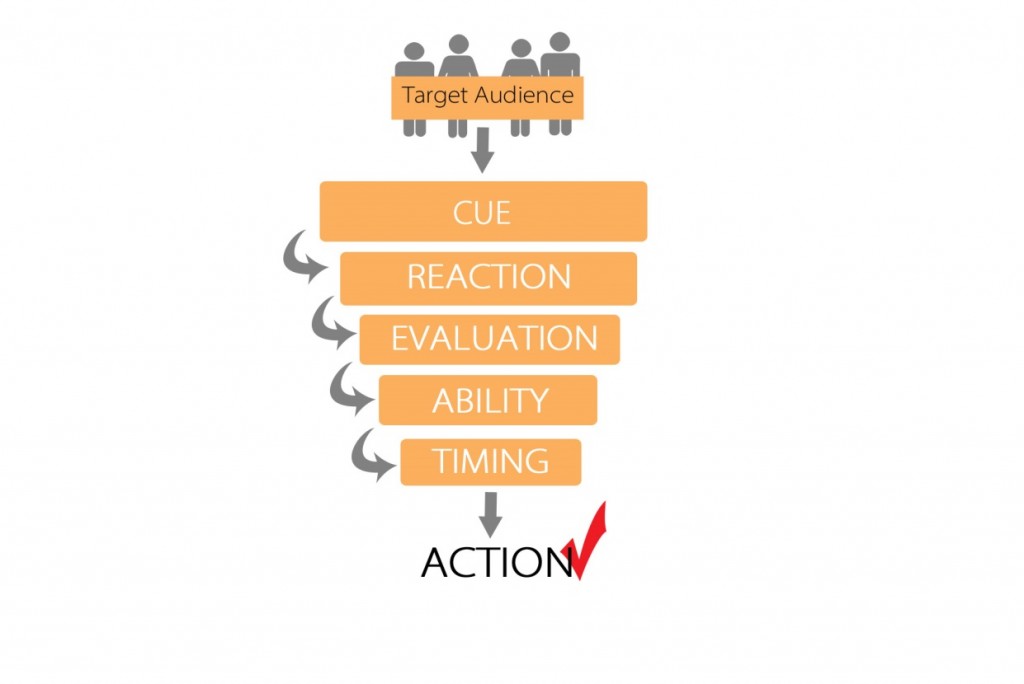 Image created for SEJ
Image created for SEJIt may seem a little daunting, but never fear: I have for you the five preconditions that you must meet for a person to interact.
Here’s what needs to happen for people to interact with you right now.
1. Cue – “I am thinking about the product”
Something needs to cue a person to think about your product. People can’t interact with you if you’re not on their mind, or worse – if they don’t know you exist.
This cue could happen in three ways:
- They are researching similar products and discover yours.
- They are referred to your product by a friend (through word of mouth or on social media).
- They see one of your ads.
Therefore, you need to make sure you optimize those three touch points (your website/SEO, your word of mouth/social media and your ads) so that people have as many chances to stumble upon your product as possible.
2. Reaction – “I feel good about the product”
Once they start considering your product, people will automatically react to the idea on an emotional level.
For example, if your product is a pair of running shoes, a person would typically feel the same way about you that they feel about exercise. If they associate running with happiness and self-confidence, they’re likely to associate your product with those feelings as well.
Obviously, consumers are more likely to continue down the funnel if they have a positive emotional response to your product, or at least a neutral one.
3. Evaluation – “The product benefits are worth the cost”
After they react to you emotionally, people will begin to consider your product on a conscious level. They evaluate its costs vs its benefits in order to decide whether or not to act. They determine how difficult it will be to use, how long it will take to use, if it has a learning curve, if it holds any value to them, etc.
Let’s say your product is a kitchen appliance, like a blender. Consumers will ask themselves: “Do I really need a blender?”;“Will I use this blender enough for it to be worth the price?”;“Will it be difficult to put together?”;“Will it take a long time to learn how to use?”;“How hard will this blender be to use, or to clean?”; etc.
In order to get to the next stage of the funnel, a person must decide that the advantages of owning the product outweigh the costs (both time and price).
4. Ability – “I can use this product”
Once they have decided the benefits are worth the cost, they have to feel confident in their ability to use your product. They must also have the resources to do so.
Pretend for a second that you’re trying to sell a new desktop computer. In order for someone to feel able to use your product, they’re going to consider if they know how computers work, or if they have any experience using one. They’ll also contemplate if they have or are willing to purchase the resources they’ll need for the computer to function properly: an Internet connection, a mouse, a keyboard, etc.
Consumers have to know that they will be able to use the product, and that they will have the right resources for it to work, before they move to the last step.
5. Timing – “I need to use this product right now”
Finally, a person needs to be encouraged to act now rather than wait.
If your product is a weight loss supplement, for example, then people need to have a reason to purchase your product right away. After all, why lose weight now when they could start next weekend?
Some people may have their own reasons for urgency – they’re getting married next month, they have to lose weight for health reasons, etc. However, most consumers are going to need a little extra motivation to act immediately.
There are a lot of examples of how companies have successfully created urgency for their customers. One of the companies that I think does this the best is Ebay. If you go to the “Daily Deals” section of the site, you’ll see a list of really great sales that are loaded with urgency.
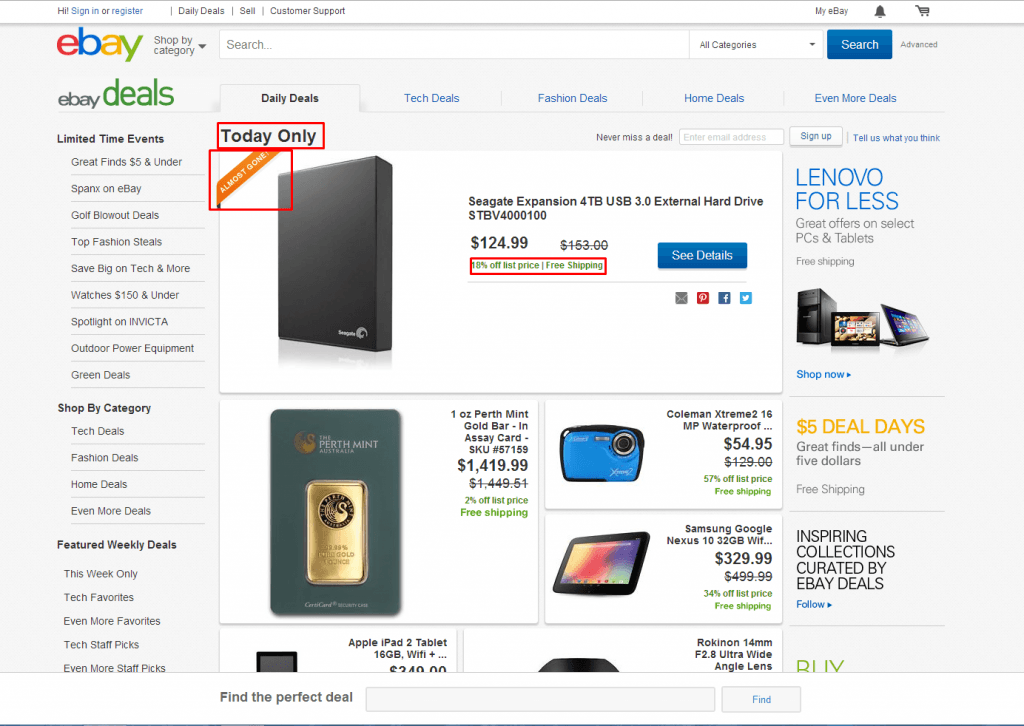 Screenshot taken on 3/21/2014 from ebay.com
Screenshot taken on 3/21/2014 from ebay.comLet’s take a look at the Seagate Expansion External Hard Drive post in the Daily Deals section. We see at the top left that this sale is for “today only”, which makes it clear that if you don’t act today, you’ll miss out on this great deal. Below that, we see that this product is “almost gone!” Forget acting today – if you want this hard drive, you have to act NOW. If you’re still not convinced, you can see that if you do act now, you’ll get “18% off list price” and free shipping.
All of these are tactics Ebay uses to instill a sense of urgency in the viewer. Is the sale really only for today? Maybe, but it’s likely they’ll post it again in the future if they don’t sell out. Are the hard drives really almost gone? Probably not – but it benefits them for you to think so.
But just wait – we haven’t even looked at real post yet:
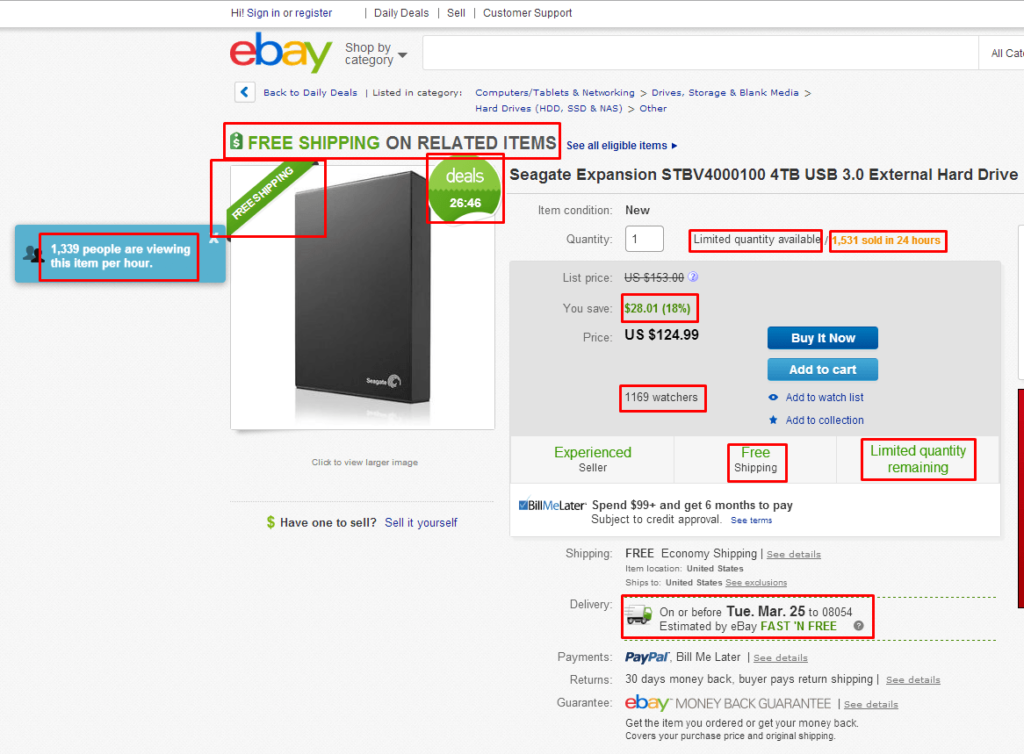 Screenshot taken 3/21/2014 from ebay.com
Screenshot taken 3/21/2014 from ebay.comEbay knows if you’re on this page, then you were so interested in the product you clicked to read more. Now’s the time to make it seem really, really urgent so you will act now to avoid missing out. And they do it on almost a dozen places just on this one page.
We again see that you can get free shipping on this product, that there is a “limited quantity available,” and that you can save 18 percent by acting now. But we also see two new tactics that really push the timing factor.
The first is the “competition” motivation. On the very left, you see a blue call-out that tells you that over 1,300 other people look at this product every hour. Also, in the product description, we see that 1,531 have been sold just in the past 24 hours, and that almost 1,200 are watching this product right now. This tactic in itself turns this product into a competition – you have to beat out all of these other people who want your product.
Right beside the product image, we see the sneakiest trick on the page – a countdown clock that ticks off every second between now and the end of the sale. The more time you spend considering buying, the less time you have to actually make the purchase – and the more opportunity you give to everyone else. It makes waiting to act sound like a risk.
All of these tactics are super successful in motivating Ebay’s customers to act now. Ebay makes 3 million transactions globally every day.
These five conditions make a sort of funnel that leads your target audience to take action and use your product. Coincidentally, they almost spell out the word “create,” which is fitting because they’re the stages to creating action in your consumers.
Possibility for Rejection
You can think of all these conditions as tests that your product must pass in order for someone to engage. However, it’s not as easy as publishing ads to cue people, or making your product cheap enough that the benefits outweigh the costs. People can reject your product at all five stages.
Here are the different ways that you can experience rejection:
1. Cue: They might not notice the cue.
- They didn’t see your site in their search results.
- They scrolled right past their friend’s post about your product on social media.
- They ignored or were distracted from your online or TV ad.
2. Reaction: They might react negatively to your product.
- They have heard or read negative reviews about your product.
- They associate your product with a negative emotion.
3. Evaluation: They might determine the cost of your product is greater than the benefit.
- Your product is too expensive for the benefits.
- Your product will take too long or be too difficult to learn, put together, or use
4. Ability: They might decide they can’t use your product, or aren’t willing to obtain the resources needed to do so.
- They can’t afford your product right now.
- They don’t have any knowledge or experience with products like yours.
- They don’t want to have to purchase extra things for the product to work.
5. Timing: They don’t feel a sense of urgency to act immediately.
- They want to wait to act.
- They are somewhere where they can’t make the purchase.
- They’re waiting to see if your product will go on sale.
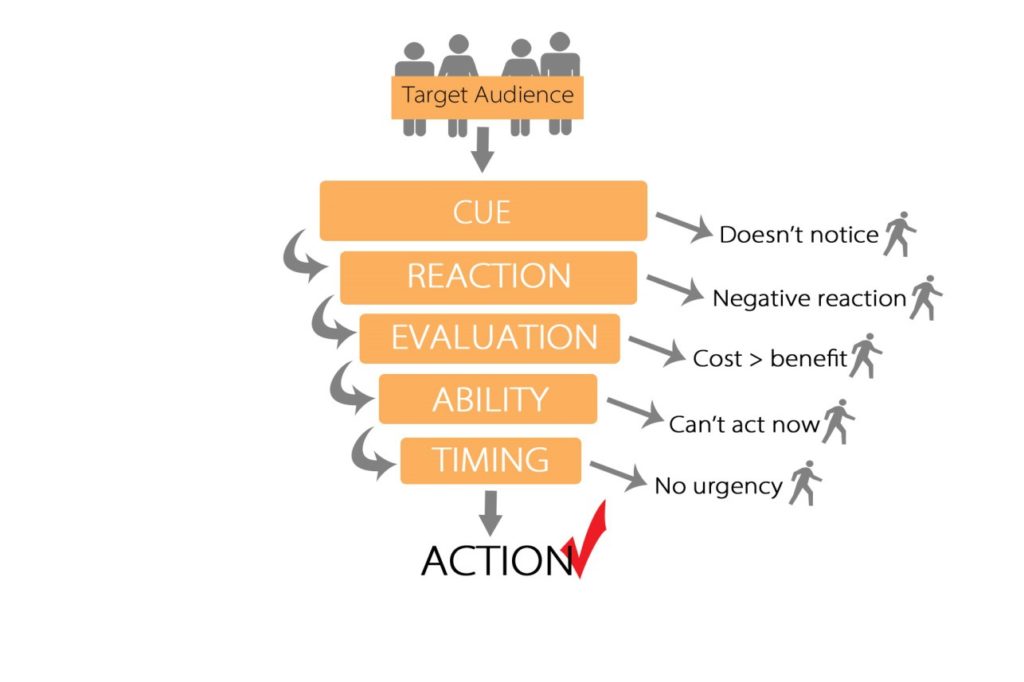 Image created for SEJ
Image created for SEJSupporting Action to Become a Habit
In order to become a Lovemark, using your products must become a habit for your users. And people have to choose to use your product again and again for your brand to become a habit. However, the action funnel is leaky, and you have the potential to lose a lot of your target audience along the way.
Therefore, you need to support action by plugging the holes. Optimize your product and your marketing plan so you meet the five preconditions every time.
Think strategically about how people will interact with your product. Establish an evident CTA, provide a sense of urgency, and build up the person’s self-confidence in their ability to use your product.
You must also be able to identify and remedy any problem areas you might be experiencing with these five steps. Maybe a lot of your customers download or purchase your product and then forget about it (a cue problem), or perhaps your product takes more time to learn than people are willing to spend (an evaluation problem). Be flexible in adapting your product to eliminate reasons why a customer might not purchase.
Conclusion
Lovemarks are those companies with illogically loyal fans that simply love their products. We all know someone who only shops at a certain store, or only eats at a specific restaurant, and refuses to go anywhere else. That’s the ultimate sign of a Lovemark – a loyal customer base that interacts with the brand out of habit.
How can you get your customers to interact with your brand so often that it becomes a habit? You have to make sure that you support action as much as possible. Consider the preconditions in the action funnel (cue, reaction, evaluation, ability, and timing) and how you can optimize your product to meet all five. This way, consumers can go right from top to bottom without getting caught up anywhere in the middle.
Eventually, they’ll use your product so much that they love it – and their love for you will be cue enough.
Featured Image: Shutter_M via Shutterstock

